AZ-204: Developing Solutions for Microsoft Azure
Implementing Azure App Configuration
Managing Application Features
This article covers the fundamental concepts of managing application features using feature flags, a feature manager, and filters. We will also demonstrate how to integrate feature management in your application with Azure App Configuration.
Feature Flag
A feature flag is an on/off switch used to enable or disable specific functionality in an application without redeploying code. This allows developers to roll out new features incrementally, test functionality in controlled groups, and prevent unwanted exposure. For example, when introducing a new login feature, you can deploy the code with a feature flag so that only a subset of users experience the new interface while others continue using the existing one.
Feature Manager
The feature manager orchestrates the lifecycle of feature flags. It initializes, manages, and applies flags within the application, dynamically evaluating which flags to enable or disable based on specific conditions. In a shopping app, for instance, the feature manager can control features like discount codes or alternative payment methods.
Filter
A filter defines criteria or conditions that determine when a feature flag is enabled or disabled. These conditions could be based on factors such as user roles, geographic location, browser type, or even a percentage of the user base. For example, a filter might enable a feature for users in a specific region or only during certain hours.

Components for Managing Application Features
Effective feature management requires a number of components:
Application with Feature Flags:
Your application must support feature flags as a core part of its development and deployment strategy. This enables selective activation of features based on user or environment.Feature Flag Repository:
A dedicated repository (such as Azure App Configuration) stores the feature flags and their statuses (enabled/disabled) independently from your application code.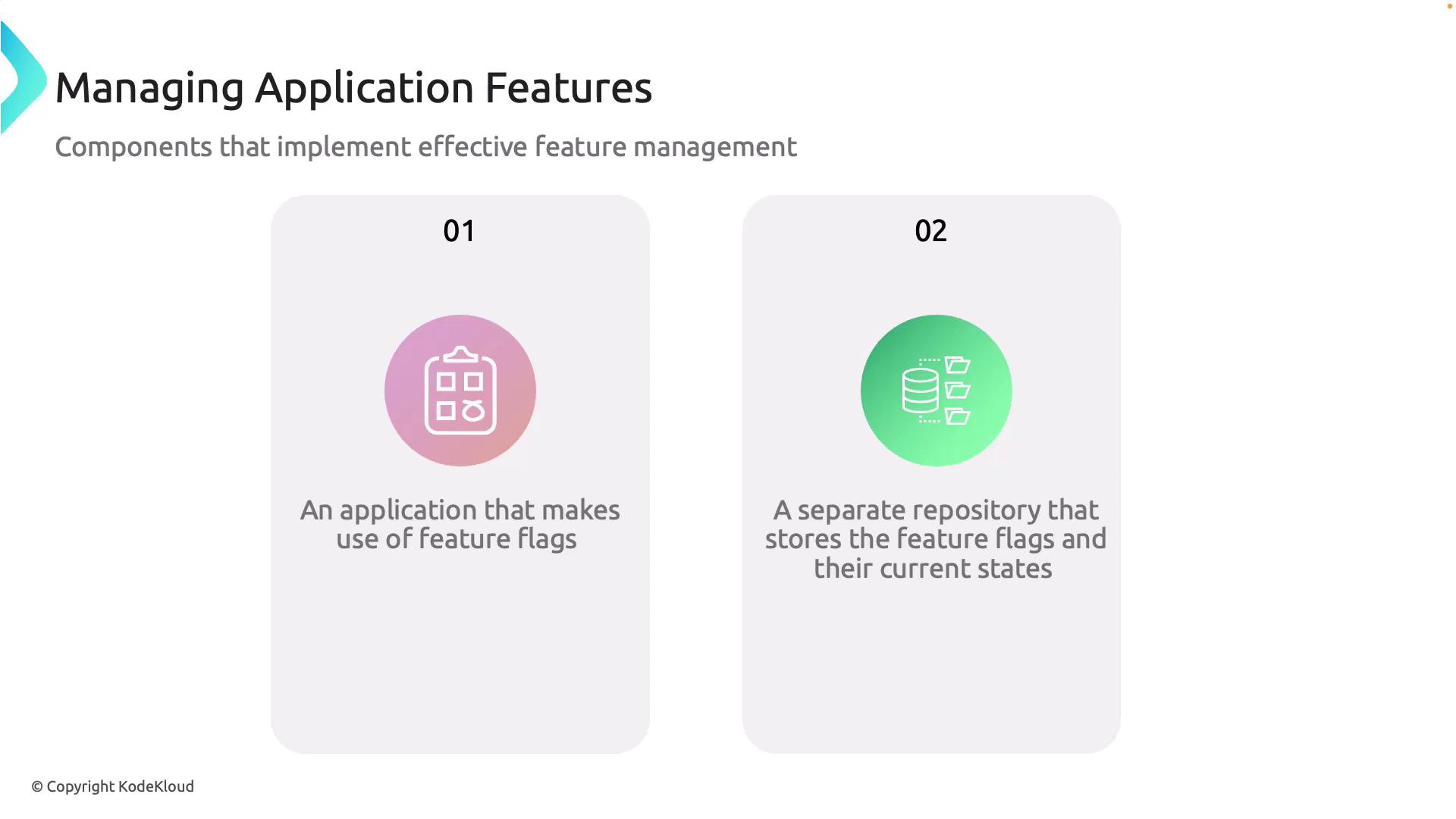
App Configuration Service:
This service provides a centralized location for storing feature flags, allowing real-time management of application configuration.
Feature Flag Declaration
Feature flags are declared using two main components:
- Name: A unique identifier for the flag.
- List of Filters: Conditions that determine whether the flag is enabled or disabled.
When multiple filters are specified, they are evaluated sequentially. As soon as one filter condition is satisfied, the feature state is set according to your defined logic. Feature managers can also support external configuration files like appsettings.json to manage flags without hardcoding them.
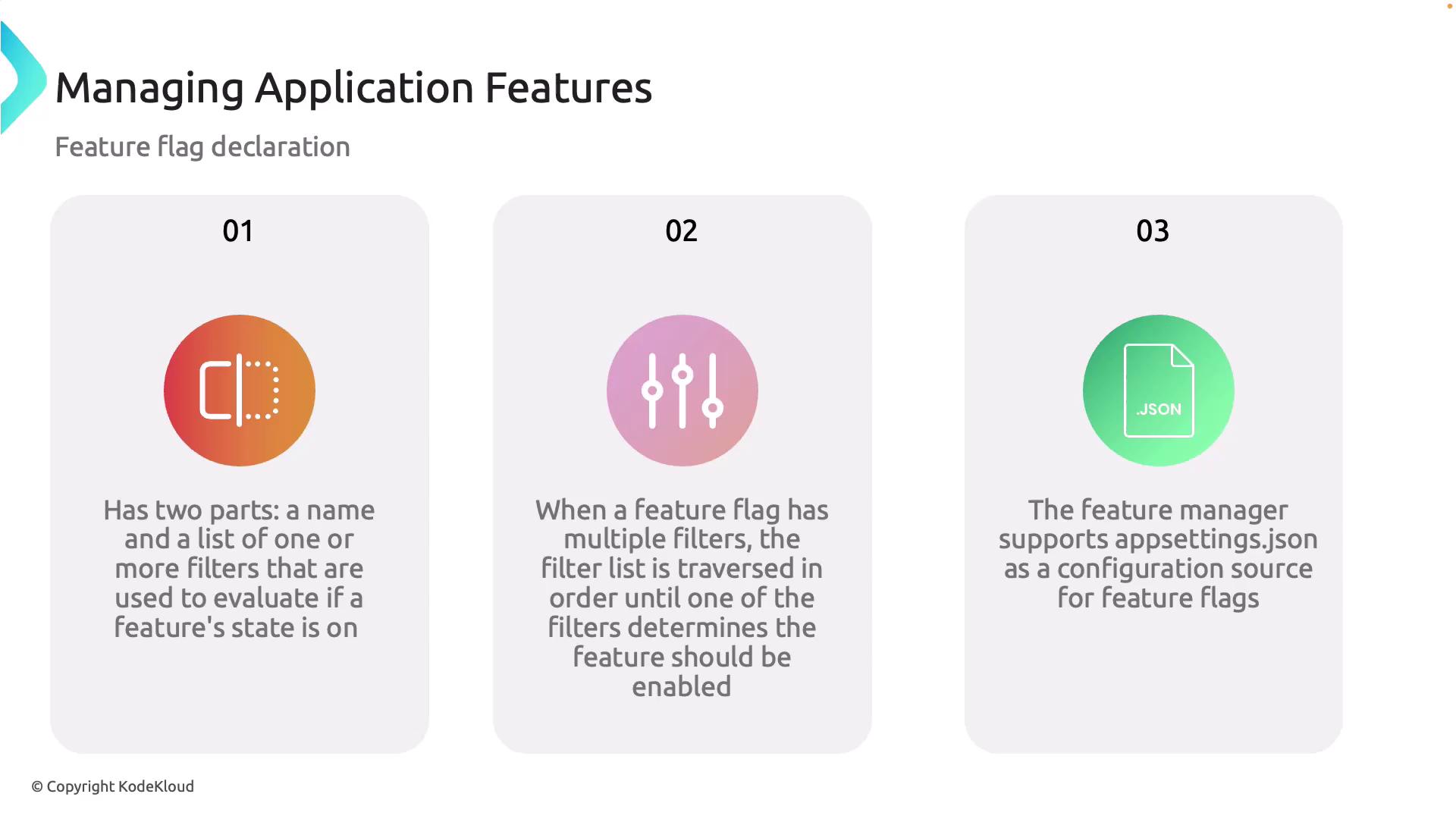
Feature Flag Repository with Azure App Configuration
For optimal use of feature flags, externalizing them is crucial. Hardcoding feature flags negates the benefit of dynamic configuration. Instead, use an external system like Azure App Configuration, which facilitates centralized management across various environments and services.

In the Azure portal, you can configure and manage feature flags, integrate Azure App Configuration into your code, and retrieve configuration values dynamically using paired keys and values.
Integrating Azure App Configuration into Your Application
Below is an example demonstrating how to integrate Azure App Configuration into an MVC application using Visual Studio Code.
Setting Up program.cs
In program.cs, add the NuGet package for Azure App Configuration and configure it with your connection string. For production scenarios, always secure your connection string using managed identities or other secure methods instead of hardcoding it.
using Microsoft.Extensions.Configuration.AzureAppConfiguration;
var builder = WebApplication.CreateBuilder(args);
// Connect to Azure App Configuration
builder.Configuration.AddAzureAppConfiguration(options =>
{
options.Connect("endpoint=https://appconfig1990.azconfig.io;Id=Id4;Secret=3cs9faC4e3CeJ3nSL2s7Y6dftGdjJhxM6rBm7UQAJQ8eyjIBTyAggEJfTt5BAACZACM30T")
.ConfigureRefresh(refresh =>
{
refresh.Register("LandingPageMessage", refreshAll: true)
.Register("LandingPageBackgroundColor", refreshAll: true)
.Register("LandingPageFontSize", refreshAll: true)
.SetCacheExpiration(TimeSpan.FromSeconds(5));
});
});
builder.Services.AddControllersWithViews();
var app = builder.Build();
app.UseRouting();
app.UseEndpoints(endpoints =>
{
endpoints.MapDefaultControllerRoute();
});
info: Microsoft.Hosting.Lifetime[0]
Hosting environment: Development
info: Microsoft.Hosting.Lifetime[0]
Content root path: /Users/rithinskaria/Projects/AppConfig
info: Microsoft.Hosting.Lifetime[0]
Application is shutting down...
info: Microsoft.Hosting.Lifetime[14]
Now listening on: http://localhost:5114
info: Microsoft.Hosting.Lifetime[0]
Application started. Press Ctrl+C to shut down.
info: Microsoft.Hosting.Lifetime[0]
Hosting environment: Development
info: Microsoft.Hosting.Lifetime[0]
Content root path: /Users/rithinskaria/Projects/AppConfig
Configuring the csproj File
Ensure that your project file includes the necessary packages:
<Project Sdk="Microsoft.NET.Sdk.Web">
<PropertyGroup>
<TargetFramework>net8.0</TargetFramework>
<Nullable>enable</Nullable>
<ImplicitUsings>enable</ImplicitUsings>
</PropertyGroup>
<ItemGroup>
<PackageReference Include="Microsoft.Extensions.Configuration.AzureAppConfiguration" Version="7.3.0" />
<PackageReference Include="Microsoft.FeatureManagement.AspNetCore" Version="3.5.0" />
</ItemGroup>
</Project>
Secure Connection String Considerations
In production environments, avoid hardcoding connection strings. Use secure methods, such as managed identities and Azure Key Vault, to access sensitive configuration data.
Configuration Explorer in Azure Portal
In Azure App Configuration, create key-value pairs for your app settings (e.g., background color, font size, welcome message). The image below shows the key-value pairs in the configuration explorer:
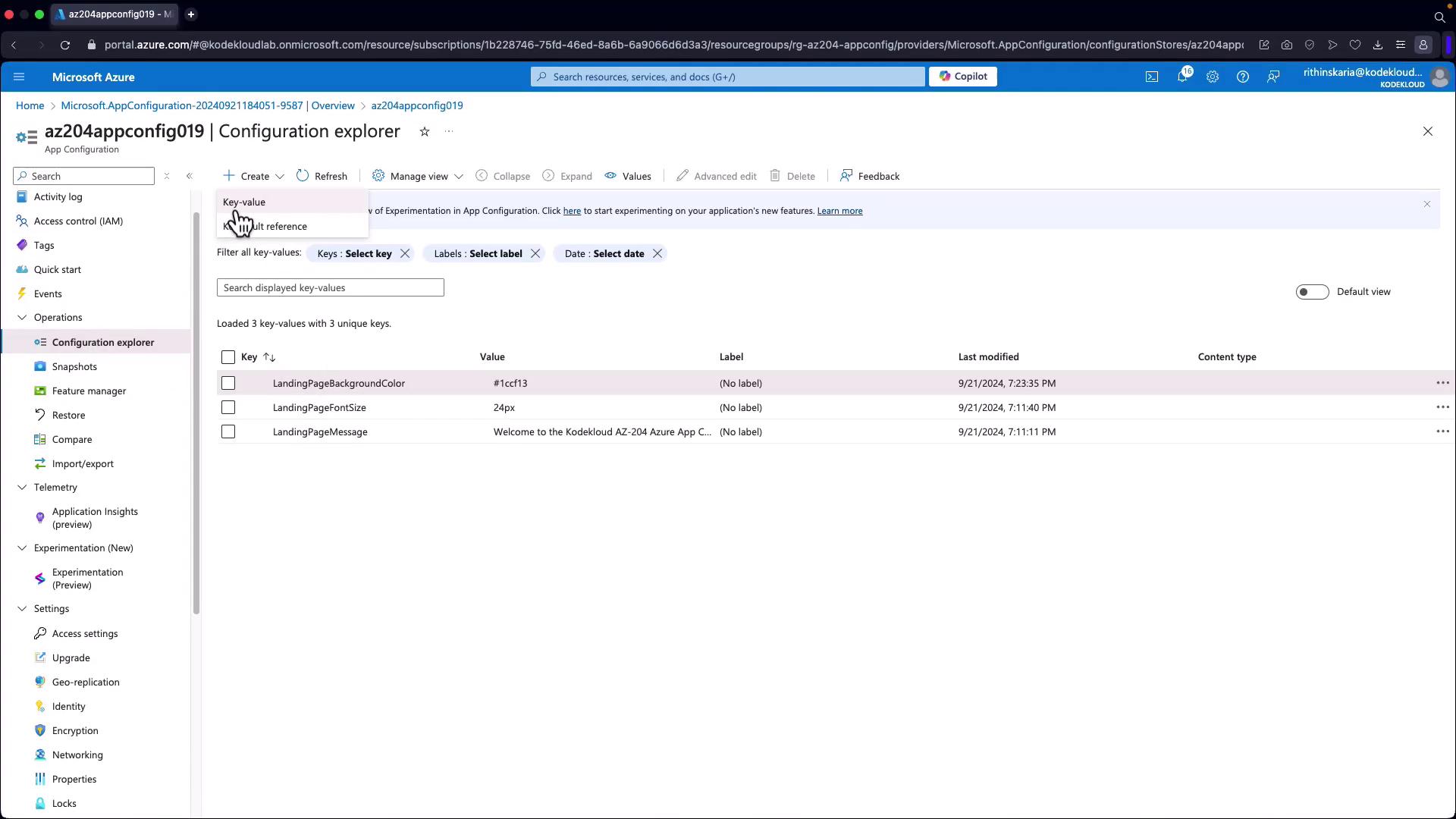
For example, you might set the landing page background color to a specific hex code, font size as a numeric value, and a custom welcome message. Caching (set to five seconds) ensures your application retrieves the latest configurations automatically.
Updated program.cs for Caching
Below is an enhanced example of program.cs with caching enabled:
using Microsoft.Extensions.Configuration.AzureAppConfiguration;
var builder = WebApplication.CreateBuilder(args);
// Connect to Azure App Configuration and set refresh options
builder.Configuration.AddAzureAppConfiguration(options =>
{
options.Connect("Endpoint=https://az204appconfig919.azconfig.io;Id=Id14;Secret=3cs9faCe4Jesd3J2sLksfVdjyJhxN6G7B7mBFL7JQ0A1JYCEjbFLTvBvSAAACAZCM30T")
.ConfigureRefresh(refresh =>
{
refresh.Register("LandingPageMessage", refreshAll: true)
.Register("LandingPageBackgroundColor", refreshAll: true)
.Register("LandingPageFontSize", refreshAll: true)
.SetCacheExpiration(TimeSpan.FromSeconds(5));
});
});
builder.Services.AddControllersWithViews();
var app = builder.Build();
app.UseRouting();
app.UseEndpoints(endpoints =>
{
endpoints.MapDefaultControllerRoute();
});
app.Run();
info: Microsoft.Hosting.Lifetime[0]
Hosting environment: Development
info: Microsoft.Hosting.Lifetime[0]
Content root path: /Users/rithinskaria/Projects/AppConfig
info: Microsoft.Hosting.Lifetime[0]
Now listening on: http://localhost:5114
info: Microsoft.Hosting.Lifetime[0]
Application started. Press Ctrl+C to shut down.
info: Microsoft.Hosting.Lifetime[0]
Hosting environment: Development
info: Microsoft.Hosting.Lifetime[0]
Content root path: /Users/rithinskaria/Projects/AppConfig
Home Controller: Accessing Configuration Values
In your HomeController, configuration values are retrieved and passed to the view. The following example demonstrates how to check for a feature flag (e.g., "ShowNewUI") and override default settings when enabled:
public class HomeController : Controller
{
private readonly IConfiguration _configuration;
private readonly IFeatureManager _featureManager;
public HomeController(IConfiguration configuration, IFeatureManager featureManager)
{
_configuration = configuration;
_featureManager = featureManager;
}
public async Task<IActionResult> Index()
{
// Default settings from App Configuration
ViewBag.Message = _configuration["LandingPageMessage"];
ViewBag.BackgroundColor = _configuration["LandingPageBackgroundColor"];
ViewBag.FontSize = _configuration["LandingPageFontSize"];
// Override settings if the "ShowNewUI" feature flag is enabled
if (await _featureManager.IsEnabledAsync("ShowNewUI"))
{
ViewBag.Message = "Welcome to the new UI";
ViewBag.BackgroundColor = "#fab691";
ViewBag.FontSize = "18px";
}
return View();
}
}
Index View
In the Index.cshtml view, use the values stored in ViewBag to set styles dynamically:
@{
ViewData["Title"] = "Home Page";
}
<div style="background-color:@ViewBag.BackgroundColor; padding:50px;">
<h1 style="font-size:@ViewBag.FontSize;">@ViewBag.Message</h1>
<p>This page is dynamically configured using Azure App Configuration.</p>
</div>
AppConfig dotnet run
Building...
Now listening on: http://localhost:5114
Application started. Press Ctrl+C to shut down.
Every time you update a value in Azure App Configuration—such as changing the background color via the Azure portal—the application will eventually reflect the new configuration thanks to caching and refresh settings. While local development might sometimes require a restart, production environments benefit from seamless configuration updates.
Managing Feature Flags with Azure App Configuration
Feature flags are managed directly through the Azure portal. Follow these steps to create and configure a feature flag:
- Click on "Create" and select "Feature Flag".
- Provide a unique name (e.g., "ShowNewUI") and optionally add a description and label.
- Add filters if you require targeted control, such as a time window filter for scheduling.
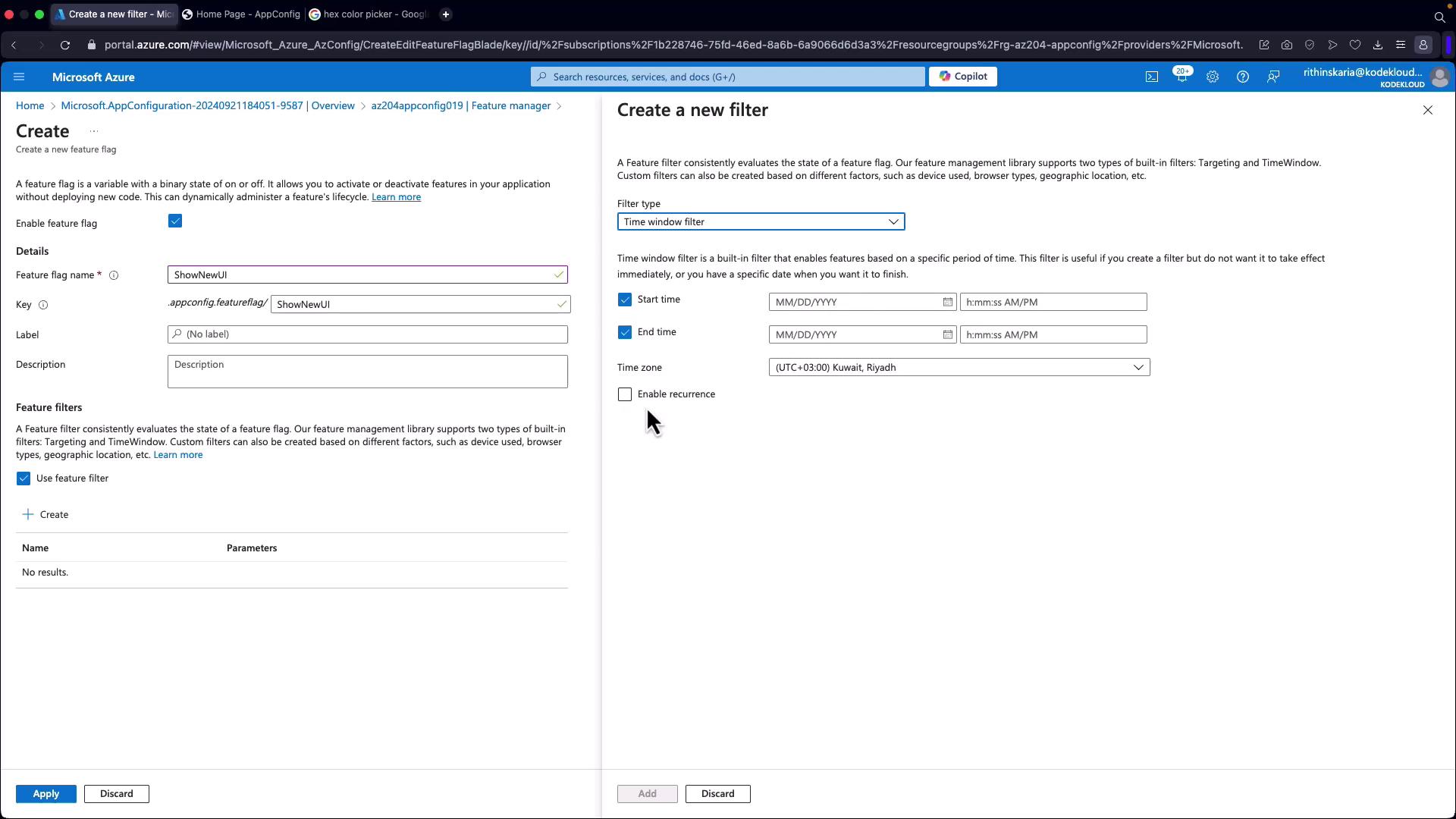
After configuring the feature flag in the portal, update your application code to incorporate feature management.
Updated program.cs for Feature Management
Below is the enhanced program.cs configuration that includes support for feature flags:
using Microsoft.Extensions.Configuration.AzureAppConfiguration;
var builder = WebApplication.CreateBuilder(args);
// Connect to Azure App Configuration with feature flag support
builder.Configuration.AddAzureAppConfiguration(options =>
{
options.Connect("Endpoint=https://az204appconfig019.azconfig.io;Id=Id;Secret=3cs9faC4e2Jc3E3r3nS1z2lSkdfwdjxHn6ER7Bm7U7JQQ9AIAcygBEFiTvD5AAACAZCM30T")
.UseFeatureFlags()
.ConfigureRefresh(refresh =>
{
refresh.Register("LandingPageMessage", refreshAll: true)
.Register("LandingPageBackgroundColor", refreshAll: true)
.Register("LandingPageFontSize", refreshAll: true)
.SetCacheExpiration(TimeSpan.FromSeconds(5));
});
builder.Services.AddAzureAppConfiguration();
builder.Services.AddFeatureManagement();
builder.Services.AddControllersWithViews();
});
var app = builder.Build();
app.UseAzureAppConfiguration();
app.UseRouting();
app.UseEndpoints(endpoints =>
{
endpoints.MapDefaultControllerRoute();
});
info: Microsoft.Hosting.Lifetime[0]
Hosting environment: Development
info: Microsoft.Hosting.Lifetime[0]
Content root path: /Users/rithinskaria/Projects/AppConfig
info: Microsoft.Hosting.Lifetime[0]
Now listening on: http://localhost:5114
info: Microsoft.Hosting.Lifetime[0]
Application started. Press Ctrl+C to shut down.
info: Microsoft.Hosting.Lifetime[0]
Hosting environment: Development
info: Microsoft.Hosting.Lifetime[0]
Content root path: /Users/rithinskaria/Projects/AppConfig
Updated csproj File for Feature Management
Ensure your project file includes the appropriate packages:
<Project Sdk="Microsoft.NET.Sdk.Web">
<PropertyGroup>
<TargetFramework>net8.0</TargetFramework>
<Nullable>enable</Nullable>
<ImplicitUsings>enable</ImplicitUsings>
</PropertyGroup>
<ItemGroup>
<PackageReference Include="Microsoft.Azure.AppConfiguration.AspNetCore" Version="7.3.0" />
<PackageReference Include="Microsoft.Extensions.Configuration.AzureAppConfiguration" Version="7.3.0" />
<PackageReference Include="Microsoft.FeatureManagement.AspNetCore" Version="5.0.0" />
</ItemGroup>
</Project>
Testing Feature Flags
In the HomeController (as shown earlier), default configuration values are overridden when the "ShowNewUI" feature flag is enabled. Activating this flag in the Azure portal will update your application UI dynamically, while disabling the flag will revert to the default configuration.
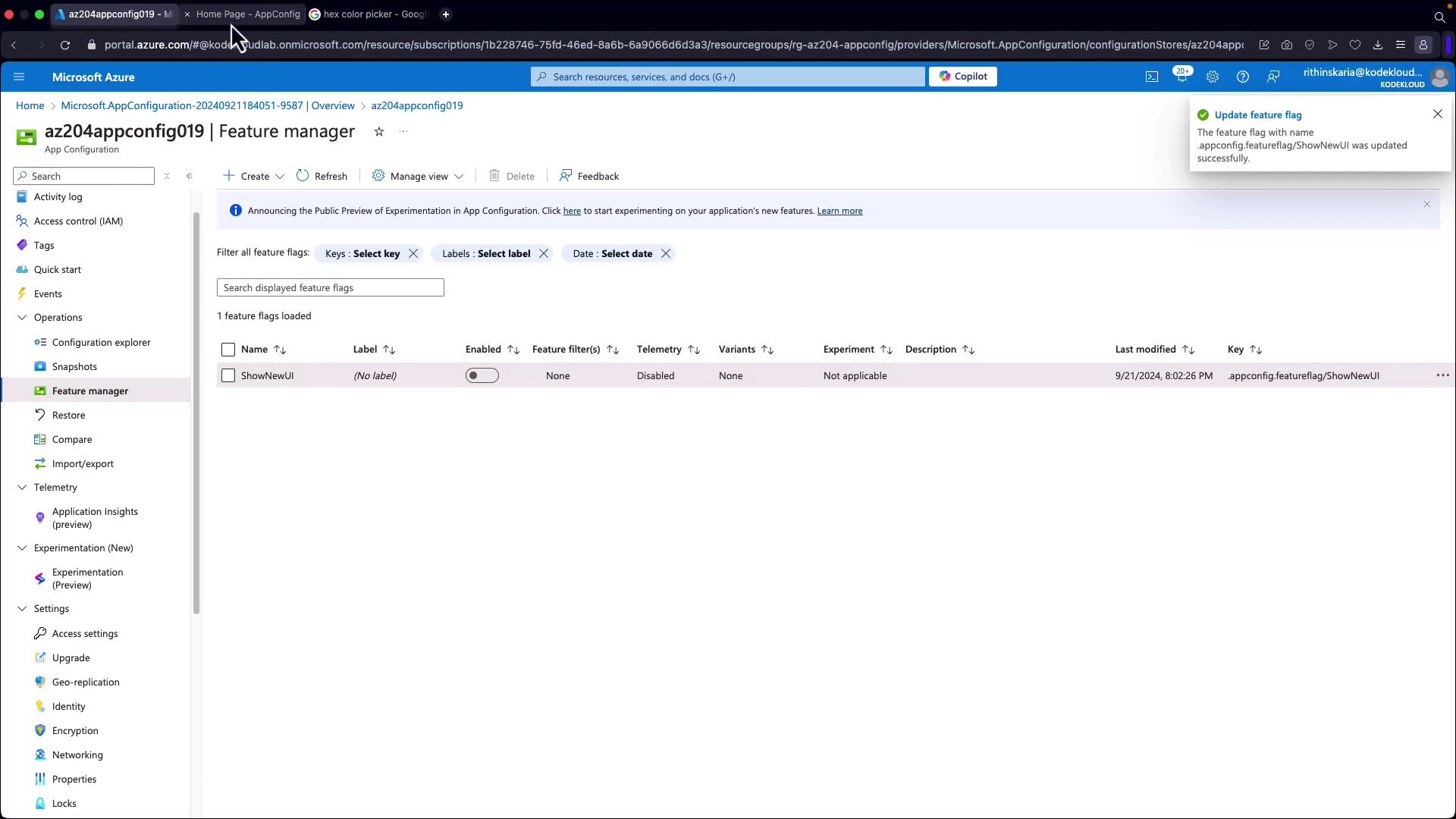
Run your application to see the changes. Refreshing the page will reflect any new configuration based on the active feature flags.
Securing App Configuration Data
Securing your configuration data is critical in production. Avoid hardcoding connection strings or sensitive data within your application. Instead, leverage managed identities and retrieve secrets from Azure Key Vault. This practice ensures secure access while maintaining dynamic configuration.
Happy coding!
Watch Video
Watch video content